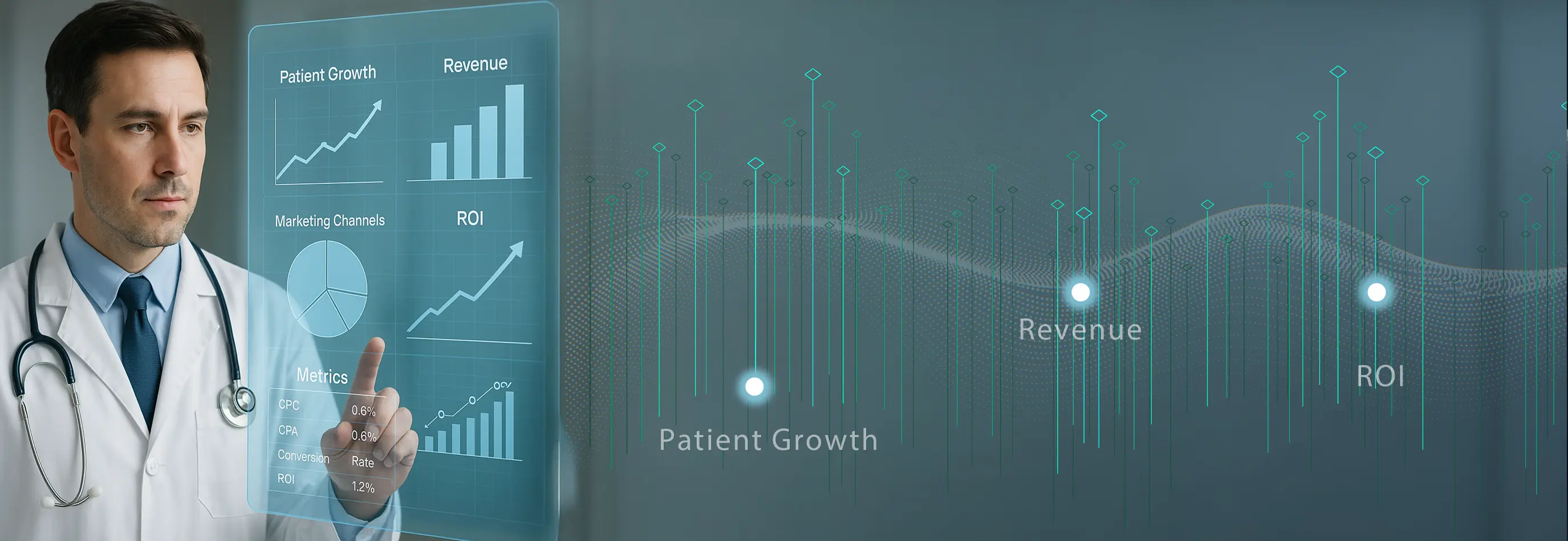From Insight to Action: The Best Ways to Know What Customers Want
Read MoreBlogs > Marketing Strategy 11-06-2025
Stop Wasting Money on Vanity Metrics: The ROI Formula Every Healthcare SME Needs
Hey there, healthcare business owners and decision-makers. Let's talk about something that’s often overlooked in the world of digital marketing: vanity metrics. We've all been there—feeling a sense of accomplishment when our social media following grows or when we see those page views climbing. But here’s the thing: these numbers can be deceiving. They don’t always reflect the real impact on your business or bottom line.
So, how do we make sure our marketing efforts are truly driving growth for your healthcare business? Let’s dive into how we can move beyond vanity metrics and focus on tracking data that actually helps you make informed decisions and create real value.
The Danger of Vanity Metrics
I get it—vanity metrics can be tempting. After all, who doesn’t love seeing a post go viral or a tweet rack up a ton of likes? But here's the catch: those likes, shares, and follower counts don’t always lead to more patients or more revenue.
Let's talk about a few of these so-called “vanity metrics” that can often steer us wrong:
- Social Media Likes and Followers: A huge following might seem impressive, but it doesn’t guarantee that your followers are interested in your services or will take action. What matters is engagement, not just numbers.
- Website Page Views: More page views look great on paper, but they don’t mean much if those visitors aren’t converting into appointments or leads.
- Email Open Rates: Yes, open rates tell you that people are clicking, but they don’t tell you if they’re actually doing something—like booking that all-important appointment.
- Website Traffic without Conversions: If lots of people are visiting your site but not booking consultations or engaging with your content, you’re missing something crucial.
The problem with focusing on these vanity metrics is that they don’t give you clear insight into what’s actually driving your business forward. They’re just numbers that look good but don’t tell the full story.
Let’s Talk About What Really Matters: Meaningful Marketing Metrics
Now that we’ve busted the myth of vanity metrics, let’s focus on the ones that really matter—metrics that align with your business goals and drive real growth. In the healthcare industry, these metrics can show you where to double down, where to pivot, and ultimately, where your marketing dollars are best spent. Here’s what you need to track:
1. Acquisition Metrics: Are You Reaching the Right Patients?
We all want to know how effectively our marketing efforts are bringing in new patients, right? Acquisition metrics help you see exactly how well you're doing at attracting new people to your practice. Here’s what to focus on:
- Cost Per Acquisition (CPA): How much does it cost you to acquire a new patient through your marketing? If your CPA is too high, it’s a red flag that something needs tweaking.
- Customer Acquisition Cost (CAC): This takes into account all the costs (marketing, sales, etc.) involved in acquiring a new patient. It’s essential to know how much you're investing to gain each new client.
- Lead Generation Rate: How many website visitors or campaign participants turn into qualified leads? If the number is low, it may be time to rethink your lead-generation strategy.
- Qualified Traffic: Is the traffic you’re getting to your website the right kind of traffic? Are these visitors likely to turn into paying patients?
Example: Let’s say your healthcare clinic runs a Facebook ad campaign, and 2% of people who click on the ad become consultations. If you spend $100 to attract 200 visitors, your CPA is $0.50. By tracking this metric, you can determine the effectiveness of your campaigns and adjust your strategy accordingly.
2. Engagement Metrics: Are You Connecting with Your Audience?
Engagement metrics show how well you're connecting with your audience. These are the numbers that show whether your patients are really engaging with your content or just passively scrolling past. Track these to understand your connection with potential patients:
- Conversion Rate: This is how many people who visit your website take the action you want, like booking an appointment or filling out a contact form. A low conversion rate might indicate that something’s off with your offer or website.
- Click-Through Rate (CTR): This shows how many people are clicking through to your website from your email, ad, or post. A high CTR means your content resonates with your audience.
- Bounce Rate: Are people coming to your site and leaving right away? High bounce rates can mean your visitors aren’t finding what they’re looking for—or that your site isn’t user-friendly enough.
- Time on Site: The longer people stay on your site, the more likely they are to take action. Time on site can indicate if your content is interesting or helpful.
Example: If you have a landing page for online appointment booking, a high conversion rate (say 10%) on that page suggests that your visitors find the process easy and the offer compelling.
3. Revenue Metrics: The Bottom Line
At the end of the day, the goal is to see a return on your marketing investment. Revenue metrics give you the clearest picture of how well your efforts are translating into financial success:
- Customer Lifetime Value (CLTV): How much revenue will a patient generate over their lifetime with your practice? It’s important for understanding the long-term value of your patients.
- Return on Ad Spend (ROAS): If you spent $1,000 on an ad campaign and brought in $3,000 worth of patient bookings, your ROAS is 3:1. The higher this number, the better.
- Marketing ROI: What’s your overall return on investment from marketing? If you’re spending more than you’re making, it’s time to adjust.
- Average Order Value (AOV): How much do patients spend each time they visit? Increasing AOV through upselling or offering bundled services can boost your revenue.
Example: You spend $500 on a targeted Facebook campaign and generate $2,500 in revenue from new patient appointments. That’s a solid 5:1 return on investment—great news!
4. Retention Metrics: Keeping Patients Coming Back
We all know that retaining a patient is much more cost-effective than acquiring a new one. Retention metrics show how well you’re maintaining relationships with your existing patients:
- Customer Churn Rate: Are patients leaving after just one visit? If so, find out why.
- Customer Retention Rate: How many patients are returning for follow-up care or routine check-ups? High retention is a sign that you're providing value.
- Repeat Purchase Rate: Are patients returning for more services or treatments? A high repeat purchase rate is a sign of strong patient loyalty.
- Customer Satisfaction Score (CSAT): How happy are your patients with their experience at your practice? A high score here often correlates with patient retention.
Example: You offer a follow-up checkup service and track how many patients return for additional visits. If 70% of your patients come back, that’s an excellent retention rate!
5. Attribution Metrics: Understanding How Your Marketing Channels Contribute
Let’s face it—healthcare marketing is a mix of many touchpoints. A potential patient might hear about your clinic through a Google ad, visit your website, and then finally book an appointment after receiving an email reminder. So, how do you figure out which part of the journey played the biggest role in that appointment? That’s where attribution metrics come in. These metrics help you see exactly which marketing channels are driving conversions, so you can optimise your efforts and spend your marketing dollars wisely.
Here’s how attribution works:
- First-Touch Attribution: This is all about the first impression. If a patient learns about your clinic through a Facebook ad, this metric credits that ad for starting the journey, even if they don’t immediately book an appointment.
- Last-Touch Attribution: This one gives credit to the last touchpoint before a conversion happens. So, if a patient finally books an appointment after receiving an email reminder, this model will say that the email made the final impact.
- Multi-Touch Attribution: This is the most holistic view, giving credit to all the channels that contributed to the conversion. If your patient first saw your Google ad, clicked through to your website, and then booked an appointment after getting your email reminder, multi-touch attribution acknowledges the combined effect of all those touchpoints in bringing the patient in.
Example: Let’s say a potential patient sees your clinic’s Google ad and visits your website. A few days later, they get an email reminder with a special offer and finally decide to book an appointment. Multi-touch attribution would help you understand that both the Google ad and the email reminder were important steps in converting that visitor into a patient.
By understanding these attribution metrics, you can make smarter decisions on where to allocate your resources, so you’re not just guessing what’s working but seeing the full picture of how your marketing is driving real results.
Putting It All Together: How to Use These Metrics to Drive Results
Now that you know what to track, the next step is implementing a strategy that’s driven by these metrics. Start by setting clear, measurable goals. These should be based on the meaningful metrics above and should focus on improving your patient acquisition, engagement, retention, and revenue.
Example SMART Goal: Increase website traffic from qualified leads by 20% in the next quarter, or boost your clinic’s conversion rate by 15% within the next month.
Using Data Analytics Tools for Healthcare Marketing
Use tools like Google Analytics, HubSpot, and social media insights to track these metrics consistently. Don’t just set it and forget it—regularly review and adjust your strategy to make sure you’re on track.
Conclusion: Let’s Move Beyond Vanity Metrics Together
I know you’re busy, but focusing on the right metrics can make all the difference in growing your healthcare business. Forget about the vanity metrics that only look good on paper. Instead, let’s focus on the data that drives real growth. By prioritising acquisition, engagement, revenue, and retention metrics, you’ll be able to measure your true ROI and make decisions that push your practice forward.
If you’re ready to take the next step and optimise your healthcare marketing, Wisoft Solutions is here to help. We specialise in data-driven strategies that bring measurable results. Let’s move beyond the fluff and start tracking what really matters—so you can grow your practice, one meaningful metric at a time.
Frequently Asked Questions:
1. What are vanity metrics in healthcare marketing?
Vanity metrics are numbers that look impressive but don’t translate into actual business growth, like social media likes or website traffic that doesn’t convert into patients.
2. How can I calculate true marketing ROI?
True ROI involves measuring revenue generated from marketing efforts and comparing it to the costs. Tools like Google Analytics and CRM software can help track this effectively.
3. Why is customer retention important in healthcare?
Retaining patients is key because it’s more cost-effective than constantly acquiring new ones. Loyal patients will return for additional services, boosting your revenue over time.
4. How can I improve my conversion rate?
Improving conversion rates can involve optimising your website’s user experience, offering clear calls to action, and targeting the right audience with personalised content.
5. What tools can help me track healthcare marketing metrics?
Google Analytics, HubSpot, and social media platforms' native analytics can all provide detailed insights into your patient acquisition, engagement, and revenue metrics.






